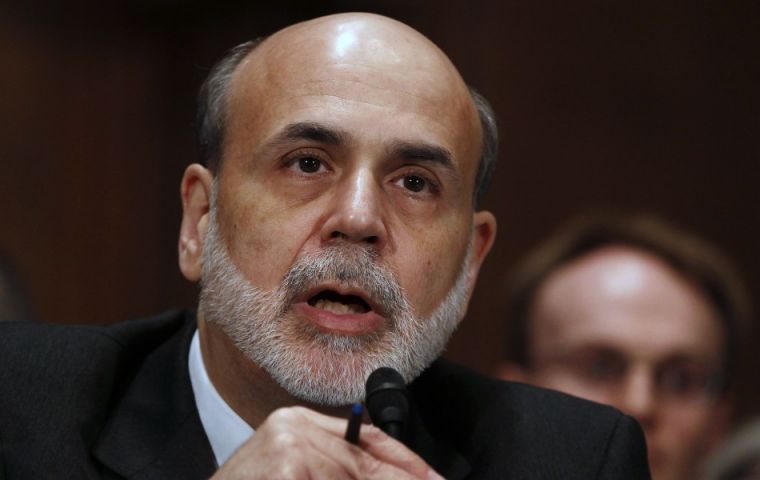MercoPress. South Atlantic News Agency
Federal Reserve anticipates low rates and current stimuli level through mid-2013
 Chairman Bernanke forecasts slower pace of recovery in coming quarters
Chairman Bernanke forecasts slower pace of recovery in coming quarters The Federal Reserve said on Tuesday it will keep its hefty monetary policy stimulus for at least another two years, an effort to support a flagging economy and fragile global markets that face considerable selling spree.
It was unclear whether the decision, which involved no new commitment of funds for bond purchases, would be enough to put a floor on a US stock market that has fallen more than 15% in the last two weeks.
The Fed said US economic growth was proving considerably weaker than expected, suggesting inflation, which has already moderated recently, will remain contained for the foreseeable future.
“The committee currently anticipates that economic conditions - including low rates of resource utilization and a subdued outlook for inflation over the medium run - are likely to warrant exceptionally low levels for the federal funds rate at least through mid-2013”, the Fed said in a statement.
It also reiterated its policy of reinvesting the proceeds from bonds maturing in its portfolio, though it did not state a specific time frame for such actions.
In its official release the Federal Open Market Committee said information received since the FOMC met in June indicates that economic growth so far this year has been considerably slower than the Committee had expected. Indicators suggest a deterioration in overall labour market conditions in recent months and the unemployment rate has moved up. Household spending has flattened out, investment in non-residential structures is still weak, and the housing sector remains depressed. However, business investment in equipment and software continues to expand.
Temporary factors, including the damping effect of higher food and energy prices on consumer purchasing power and spending as well as supply chain disruptions associated with the tragic events in Japan, appear to account for only some of the recent weakness in economic activity. Inflation picked up earlier in the year, mainly reflecting higher prices for some commodities and imported goods, as well as the supply chain disruptions.
More recently, inflation has moderated as prices of energy and some commodities have declined from their earlier peaks. Longer-term inflation expectations have remained stable.
Consistent with its statutory mandate, the Committee seeks to foster maximum employment and price stability. The Committee now expects a somewhat slower pace of recovery over coming quarters than it did at the time of the previous meeting and anticipates that the unemployment rate will decline only gradually toward levels that the Committee judges to be consistent with its dual mandate.
Moreover, downside risks to the economic outlook have increased. The Committee also anticipates that inflation will settle, over coming quarters, at levels at or below those consistent with the Committee's dual mandate as the effects of past energy and other commodity price increases dissipate further. However, the Committee will continue to pay close attention to the evolution of inflation and inflation expectations.
To promote the ongoing economic recovery and to help ensure that inflation, over time, is at levels consistent with its mandate, the Committee decided today to keep the target range for the federal funds rate at 0 to 1/4 percent.
The Committee currently anticipates that economic conditions--including low rates of resource utilization and a subdued outlook for inflation over the medium run--are likely to warrant exceptionally low levels for the federal funds rate at least through mid-2013.
The Committee also will maintain its existing policy of reinvesting principal payments from its securities holdings. The Committee will regularly review the size and composition of its securities holdings and is prepared to adjust those holdings as appropriate.
The Committee discussed the range of policy tools available to promote a stronger economic recovery in a context of price stability. It will continue to assess the economic outlook in light of incoming information and is prepared to employ these tools as appropriate.
Voting for the FOMC monetary policy action were: Ben S. Bernanke, Chairman; William C. Dudley, Vice Chairman; Elizabeth A. Duke; Charles L. Evans; Sarah Bloom Raskin; Daniel K. Tarullo; and Janet L. Yellen.
Voting against the action were: Richard W. Fisher, Narayana Kocherlakota, and Charles I. Plosser, who would have preferred to continue to describe economic conditions as likely to warrant exceptionally low levels for the federal funds rate for an extended period.




Top Comments
Disclaimer & comment rules-

-

-

Read all commentsi don't guess the streets can wait until 2013....!
Aug 09th, 2011 - 08:26 pm 0@ 1 Your English is really bad. No one understands what you're saying.
Aug 09th, 2011 - 09:58 pm 0print print print print more digital money that isn't worth on paper it's printed on.
Aug 10th, 2011 - 01:44 am 0Commenting for this story is now closed.
If you have a Facebook account, become a fan and comment on our Facebook Page!